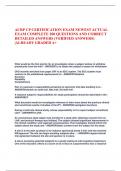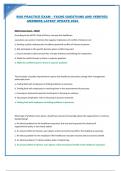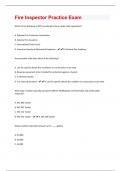, Buckwold, liKitunen, liRoman liand liIqbal, liCanadian liIncome liTaxation, li2023-2024 liEd.
CHAPTER 1 li
TAXATION― ITS ROLE IN BUSINESS DECISION MAKING li li li li li li
Review Questions
li
1. If income tax is imposed after profits have been determined, why is taxation relevant to
li li li li li li li li li li li li li li
business decision making?
li li li
2. Most business decisions involve the evaluation of alternative courses of action. For
li li li li li li li li li li li
example, a marketing manager may be responsible for choosing a strategy for
li li li li li li li li li li li li
establishing sales in new geographical territories. Briefly explain how the tax factor can be an
li li li li il il il li il il il li li il li
integral part of this decision.
li li li li li
3. What are the fundamental variables of the income tax system that decision-makers should be
il il il il il il il il li il li il li
familiar with so that they can apply tax issues to their areas of responsibility?
li li li li li li li li li li li li li li
4. What is an “after-tax” approach to decision making?
li li li li li li li
Copyright li© li2023 liMcGraw liHill liLtd. 1
Instructor liSolutions liManual liChapter liOne
, Buckwold, liKitunen, liRoman liand liIqbal, liCanadian liIncome liTaxation, li2023-2024 liEd.
Solutions to Review Questions li li li
R1-1 Once profit is determined, the Income Tax Act determines the amount of income tax that
l i li li li li li li li li li li li li li li
results. However, at all levels of management, alternative courses of action are evaluated.
li li li li li li li li li li li li li
In many cases, the choice of one alternative over the other may affect both the amount and the
li li li li li li li li li li li li li li il li li li
timing of future taxes on income generated from that activity. Therefore, the person
li li li li li li li li li li li li li
making those decisions has a direct input into future after-tax cash flow. Obviously,
li li li li li li li li li li li li li
decisions that reduce or postpone the payment of tax affect the ultimate return on
li li li li li li li li li li li li li li
investment and, in turn, the value of the enterprise. Including the tax variable as a part of
li li li li li li li li li li li li li li li li li
the formal decision process will ultimately lead to improved after-tax cash flow.
li li li li li li li li li li li li
R1-2 Expansion can be achieved in new geographic areas through direct selling, or by
li li li li li li li li li li li li li
establishing a formal presence in the new territory with a branch office or a separate
li li li li li li li li li li li li li li li
corporation. The new territories may also cross provincial or international boundaries.
li li li li li li li li li li li
Provincial income tax rates vary amongst the provinces. The amount of income that is
li li li li li li li li li li li li li li
subject to tax in the new province will be different for each of the three alternatives
li li li li li li li li li li li li li li li li
mentioned above. For example, with direct selling, none of the income is taxed in the new
li li li li li li li li li li li li li li li li
province, but with a separate corporation, all of the income is taxed in the new province.
li li li li li li li li li li li li li li li li
Because the tax cost is different in each case, taxation is a relevant part of the decision and
li il il li il il li li li il il li li li li li il il
must be included in any cost-benefit analysis that compares the three alternatives [Reg.
li li li li li li li li li li li li li
400-402.1].
li
R1-3 A basic understanding of the following variables will significantly strengthen a
l i li li li li li li li li li li
decision maker's ability to apply tax issues to their area of responsibility.
li li li li li li li li li li li li
Types of Income li li - Employment, Business, Property, Capital gains li li li li
li Taxable Entities li - Individuals, Corporations, Trusts li li
Alternative Business li - Corporation, Proprietorship, Partnership, Limited il li il
Structures li partnership, Joint arrangement, Income trust li li li li
Tax Jurisdictions li - Federal, Provincial, Foreign li li
R1-4 All cash flow decisions, whether related to revenues, expenses, asset acquisitions or
li li li li li li li li li li li li
divestitures, or debt and equity restructuring, will impact the amount and timing of the tax
li li li li li li li li li li li li li li li
cost. Therefore, cash flow exists only on an after tax basis, and, the tax impacts whether or
li li li li li li li li li li li li li li li li li
not the ultimate result of the decision is successful. An after-tax approach
li l i l i l i l i l i l i l i l i l i l i l i
to decision-making requires each decision-maker to think "after-tax" for every decision
l i l i li li li li li li li li li
at the time the decision is being made, and, to consider alternative courses of action to
li li li li li li li li li li li li li li li li
minimize the tax cost, in the same way that decisions are made regarding other types of
li li li li li li li li li li li li li li li li
costs. li
Failure to apply an after-tax approach at the time that decisions are made may provide
li li li li li li li li li li li li li li
inaccurate information for evaluation, and, result in a permanently inefficient tax structure.
li li li li li li li li li li li li
Copyright li© li2023 liMcGraw liHill liLtd. 2
Instructor liSolutions liManual liChapter liOne
, Buckwold, liKitunen, liRoman liand liIqbal, liCanadian liIncome liTaxation, li2023-2024 liEd.
CHAPTER 2 li
FUNDAMENTALS OF TAX PLANNING li li li
Review Questions
li
1. “Tax planning and tax avoidance mean the same thing.” Is this statement true? Explain.
li li li li li li li li li li li li li
2. What distinguishes tax evasion from tax avoidance and tax planning?
li li li li li li li li li
3. Does Canada Revenue Agency deal with all tax avoidance activities in the same way?
li li li li li li li li li li li li li
Explain.
li
4. The purpose of tax planning is to reduce or defer the tax costs associated with financial
li li li li li li li li li li li li li li li
transactions. What are the general types of tax planning activities? Briefly explain how
li li li li li li li li li li li li li
each of them may reduce or defer the tax cost.
li li li li li li li li li li
5. “It is always better to pay tax later rather than sooner.” Is this statement true? Explain.
li li li li li li li li li li li li li li li
6. When corporate tax rates are 13% and tax rates for individuals are 40%, is it always better for
il il il il li il li il il li li il il li il li li
the individual to transfer their business to a corporation?
li li li li li li li li li
7. “As long as all of the income tax rules are known, a tax plan can be developed with
li li li li li li li li li li li li li li li li li
certainty.” Is this statement true? Explain.
li li li li li li
8. What basic skills are required to develop a good tax plan?
li li li li li li li li li li
9. An entrepreneur is developing a new business venture and is planning to raise equity
li li li li li li li li li li li li li
capital from individual investors. Their adviser indicates that the venture could be
li li li li li li li li li li li li
structured as a corporation (i.e., shares are issued to the investors) or as a limited
li li li li li li li li li li li li li li li
partnership (i.e., partnership units are sold). Both structures provide limited liability for the
li li li li li li li li li li li li li
investors. Should the entrepreneur consider the tax positions of the individual investors?
li li li li li li li li li li li li
Explain. W ithout dealing with specific tax rules, what general tax factors should an investor
li il il il il il il il il il il il il il
consider before making an investment?
li li li li li
10. What is a tax avoidance transaction? li li li li li
11. “If a transaction (or a series of transactions) that results in a tax benefit was not undertaken
il il il il il il il il il il il il il il il il
primarily for bona fide business, investment, or family purposes, the general anti-
li li li li li li li li li li li li
avoidance rule will apply and eliminate the tax benefit.” Is this statement true? Explain.
li li li li li li li li li li li li li li
Copyright li© li2023 liMcGraw liHill liLtd. 1
liInstructor liSolutions liManual liChapter liTwo








